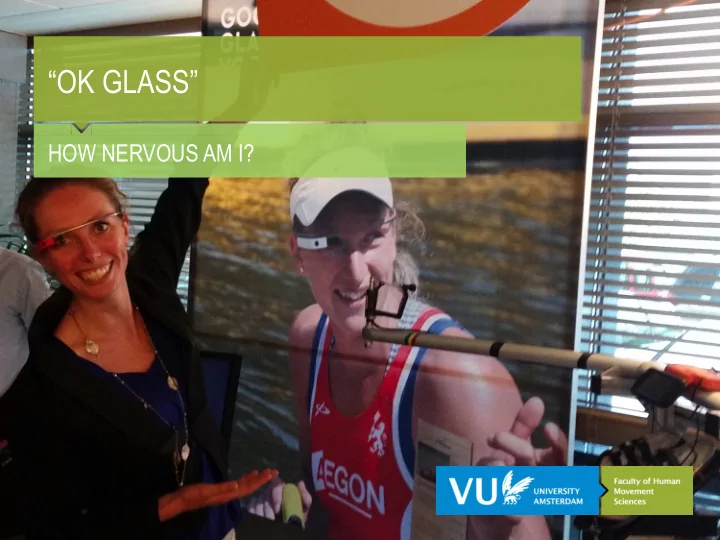

“OK GLASS” HOW NERVOUS AM I?
REAL-TIME FEEDBACK IN ROWING EXAMPLE : FEEDBACK ON POWER LOSS DUE TO VELOCITY FLUCTUATIONS Lotte Lintmeijer
CONTENT Ø Project: “the bigger picture” Ø Background Ø Aim Ø Feedback Ø Power equation Ø Example: “feedback on power loss ” Ø Aim of the study Ø Methods Ø Results Ø Conclusions 3 Faculty of Human Movement Sciences
PROJECT “THE BIGGER PICTURE
BACKGROUND Previous research on influence of feedback on performance Ø Motor learning Ø In lab Ø Simple tasks Ø Novices Ø Biomechanics Ø New feedback technologies Ø Quantifying movement patterns Ø Multi-disciplinary focus is required (Bron: Philips et al.,2013) 5 Faculty of Human Movement Sciences
AIM OF THE PROJECT Main Goal: Ø Support coaches and rowers with effective feedback in order to optimize performance Ø Insight in the power equation Ø Development of effective feedback tools 6 Faculty of Human Movement Sciences
FEEDBACK Criteria for effective feedback (tools) Ø A key to improve performance Ø Able to be adapted by the athlete Ø Measured valid and reliable (Bron: Philips et al.,2013) 7 Faculty of Human Movement Sciences
EFFECTIVE FEEDBACK PARAMETERS IN ROWING: Kinematics as key variable: Is there a golden standard? (Bron: Kleshnev, 2004) 8 Faculty of Human Movement Sciences
FEEDBACK PARAMETERS: Force curves as key variable: is there an optimum? A B C Bron: M. Hofmijster 9 Faculty of Human Movement Sciences
FEEDBACK PARAMETERS: Force curves as key variable: is there an optimum? A B C Bron: M. Hofmijster Dutch National Champion A ‘random’ Amateur A World Champion 10 Faculty of Human Movement Sciences
FEEDBACK PARAMETERS: Force Force should be related to velocity Force x velocity = Power (Watt ) P athlete = key variable for performance 11 Faculty of Human Movement Sciences
FEEDBACK PARAMETERS: POWER EQUATION P athlete = - (P drag + P blade + P ∆ V ) Effective Waste Velocity fluctuations in rowing Ø Large moving mass Ø No constant propulsion Ø More fluctuations is a need of more power input for the same average speed 12 Faculty of Human Movement Sciences
FEEDBACK PARAMETERS: POWER EQUATION Advantages Ø Force and velocity combined Ø Effect of the technique of rower visible Ø Search for Optimal trade-off 13 Faculty of Human Movement Sciences
FEEDBACK PARAMETERS: POWER EQUATION Key parameter Adjustable Measurable (criteria 1) (criteria 2) (criteria 3) P athlete √ √ P drag √ ? P blade ? ? P ∆ V ? √ 14 Faculty of Human Movement Sciences
EXAMPLE STUDY “THE EFFECT OF FEEDBACK ON POWER LOSSES DUE TO VELOCITY FLUCTUATIONS”
EXAMPLE STUDY: AIM OF THE STUDY Ø Aim: Ø Examining whether rowers could adjust their behavior due to feedback on P ∆ V Ø Main Question: Ø Is real-time feedback on velocity fluctuations as effective in minimizing power losses as traditional coaching? Ø Performance parameter: P ∆ V Ø Feedback parameter: P ∆ V 16 Faculty of Human Movement Sciences
EXAMPLE STUDY: REAL-TIME FEEDBACK Faculty of Human Movement Sciences
EXAMPLE STUDY: METHODS Ø Feedback and outcome parameter: Ø P ∆ V : Power loss due to velocity fluctuations PP 1 week 1 week Faculty of Human Movement Sciences
EXAMPLE STUDY: RESULTS Power loss during pretest and posttest 1. Visual FB was rated with a 7 with real-time feedback 7 2. Auditive FB was 6,8 rated with a 5.1 6,6 6,4 3. No change in P ∆ V Power loss 4. No difference 6,2 between effect of 6 coach and effect of real-time feedback 5,8 5,6 Responders (3 pp) 5. Descriptives show 5,4 individual differences Non-responders (4 5,2 pp) Counter-Responders 5 (2 pp) pretest posttest Faculty of Human Movement Sciences
EXAMPLE STUDY: CONCLUSIONS Criteria Ø P ∆ v as a key parameter Ø Adjustable for rowers? Ø Measurable? Controlled field study Ø Required Ø But time consuming Ø Noise Next steps 20 Faculty of Human Movement Sciences
QUESTIONS? More information: www.rowingscience.nl 21 Faculty of Human Movement Sciences
Recommend
More recommend